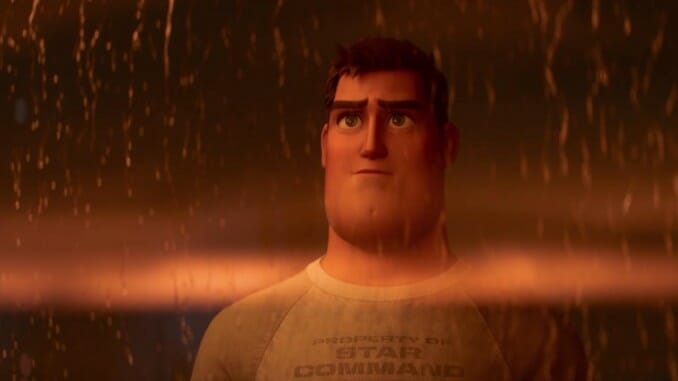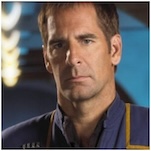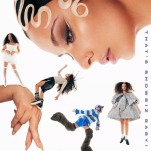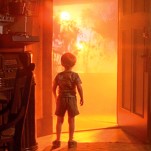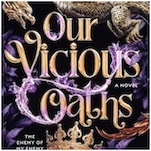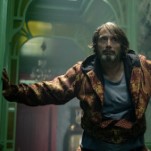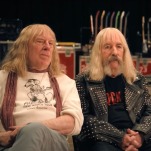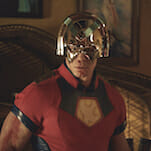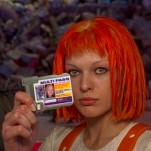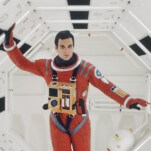I have seldom been so confused by something so simple as I have been by this trailer. There is a movie coming out starring Buzz Lightyear, but not the CGI astronaut adventurer toy Buzz Lightyear. Rather, it’s the CGI astronaut adventurer Buzz Lightyear. No, I don’t understand it either. Let’s try to get to the bottom of it with the classic detective questions: Who, what, when, where, why? The “when” is June 17, 2022. The “where” is every cinema Disney can get it on. The who, what, and why, however, are deceptively complicated to answer.
Who is Buzz Lightyear? Well, there are a few ways to answer this. Buzz Lightyear is one of the protagonists of the Disney-Pixar franchise Toy Story, which is about the secret life of toys; apparently they’ve all got souls, even if you make one out of a fork, pipe cleaners and crayon, as we learned in Toy Story 4. The plot of the first film is about Buzz Lightyear figuring out that he’s a toy and not an actual spaceman. A subplot in the second film featuring another Buzz Lightyear action figure (“Utility Belt Buzz Lightyear”) and an Evil Emperor Zurg action figure helped spur a Buzz Lightyear ABC/UPN spin-off cartoon series set in the universe where he’s an actual spaceman. Now, for some reason, we’re getting an animated movie set in an adjacent universe where Buzz Lightyear is a real person. However, the new Star Command looks more like NASA, where the old Star Command was more fantasy space cop, drawing from sources such as Green Lantern, Star Trek, and Star Wars.
Buzz Lightyear was voiced by Tim Allen in the first Pixar movies, by Patrick Warburton in the single 62-episode season of the spin-off cartoon, and by Chris Evans (whom the audience of this film will primarily know as Captain America) in Lightyear. It makes some sense that Disney-Pixar would want to separate Tim Allen’s voice from the character, because he’s older than the character in this film appears to be, and because the Allen Buzz Lightyear is decidedly a toy. The Evans Buzz Lightyear is a real person, of sorts. But we’ll get to that.
Tim Allen was also famously arrested for cocaine possession (getting a shorter sentence for turning in his friends) in the 1970s, but that didn’t stop him getting the original role. However, perhaps his more recent loud turn toward advocating neo-conservative politics has made him less marketable, whereas Chris Evans is widely appraised as lovable. I don’t think Allen comparing being a conservative in the U.S. to being a Jewish person in Nazi Germany affected the sales figures of Toy Story 4, but a lot of conservative websites are sure that he’s being replaced for being a conservative. It’s a far simpler explanation that Disney-Pixar are just looking for a new voice as they bring the character into a new era. That’s the “who” sorted.
Trying to figure out why Lightyear exists and what it actually is is a fun little puzzle. There are of course the cynical and obvious explanations: Disney wants to sell toys and continue an established property. After four films with the spaceman toy—the central thrust of his arc in the first film being that he needed to accept that he was “a child’s play thing”—it’s kind of weird to see an origin story film that’s sort of a behind-the-scenes, “true story behind the doll” appear unbidden, though it was announced in December 2020. I mean, obviously someone at Disney bade it, but I don’t think I know a single person who hasn’t seen Toy Story, yet I haven’t heard a request for a solo alternate-universe Toy Story piece of art in two decades, give or take a year.
For those trying to get a handle on the situation, the “what” became more confounding in part because of Evans’ clarifying tweet, which, for me and the people in this Polygon discussion, served only to cause more confusion:
Like, is Buzz Lightyear a real person? Wouldn’t we have noticed if the Toy Story films were set in a world where humanity was spacefaring and aliens had been discovered?
But the comments to that article led me to an AV Club article where Lightyear writer Pete Docter (Pixar CCO and director of Monsters Inc., Up, Inside Out and Soul) explains that Buzz Lightyear was originally conceived as a toy based on a sci-fi blockbuster within the universe of the original Toy Story, and that Lightyear is intended to be that sci-fi blockbuster: “Back when we created the first Toy Story, we designed Buzz Lightyear with the idea that he was a toy based on some really cool character from an epic blockbuster film. Well, all these years later, we decided to make that film.”
So that is “what” Lightyear is: An epic blockbuster film that, within the canon of the Toy Story world, inspired millions of parents to buy their kids the toy that those of us in the real world were bought because of Toy Story. According to the commercial from the first movie, this means we should expect to see Chris Evans Buzz Lightyear do some karate chopping, and his suit should include wings.
So why are we here? I always thought of Buzz Lightyear as being a child’s toy based on a child’s cartoon. And I thought of Buzz Lightyear of Star Command as the realization of that cartoon. The design of the characters was much more in line with how Buzz looked in the Toy Story films than what he looks like in Lightyear, which is closer to having realistic proportions. Of course, that cartoon came out 20 years ago, when I was in the beginning of elementary school. I was the target demographic then; there’s a whole new group of kids a generation and change younger than me that are the target demographic now. They’re being sold different goods; the Buzz Lightyear of Star Command intro explained that the show was fictional within the canon of the movies and presupposed that people coming to the cartoon would be familiar with the movie series. Lightyear’s trailer makes no mention of Toy Story, using Buzz’s iconic catchphrase to evoke nostalgia for the my-age audience, while perhaps invoking awe for newcomer children with its photorealistically designed world. Maybe they’ll eat it up.
Toy Story 3 came out between my junior and senior year of high school. We watched it as a class on Senior Movie Night and felt a connection because we were all going through what Andy’s going through in that movie: Getting ready to leave high school, maybe go off to college, let go of our pasts and try to leave the parts we love most for someone else to pick up and appreciate. Toy Story 4 came out nine years later because Disney-Pixar felt like they had a marketable idea they could still use. It made a literal billion dollars and holds a 97% approval rating on Rotten Tomatoes, so evidently it was a good bet. But even those kids had a specific idea of Buzz Lightyear as a toy in Toy Story: A heroic toy, a selfless toy, a toy that looks like an adventuring space marine—but a toy nonetheless.
So, now you’ve got grown adults with kids of their own—people my age and older—who might come to see a Toy Story spin-off because of nostalgia and wanting to pass something down to their kids. Yet it would require a specific kind of a fan to think of Buzz Lightyear as a character that is precious and in need of a serious reconsideration away from his toy origins. Perhaps giving the character more depth comes from a need to give the older people in the audience something new to chew on while still tied to a familiar name (if not face), while children just beginning to form their tastes will watch whatever.
From a marketing and release standpoint, the timeline is something like Incredibles 2 coming out 14 years after Incredibles and Monsters University coming out 12 years after Monsters Inc.. But, whereas Monsters University was a prequel providing unneeded origin stories (the main function of prequels) and Incredibles 2 basically recycled the plot of the original while switching the focal point from Mr. to Mrs. Incredible, this is a wholecloth new story derived from existing IP. And it is focusing its reverence around a character who, in the original Toy Story and its sequels—as well as Buzz Lightyear of Star Command—is an intentionally comical representation of characters from adventure serials and sci-fi adventure movies. Why make it “real” now?
Considering Pixar has had quite a few movies in the past decade that make you think or pull at your heartstrings in ways you didn’t expect, it isn’t impossible that Lightyear could be good, despite how it looks and feels in the trailer (which features David Bowie’s “Starman” for extra emphasis on both seriousness and adventure). But regardless of that chance, or how cynically we can estimate the creative calculus, the impending existence of Lightyear feels very strange. Sort of like how there’s an earnest Ghostbusters reboot coming out after the last reboot—more tonally consistent with the original idea but relying too much on improv and too little on direction—failed (it only made 150% of its budget instead of 300-400%).
So the obvious answer to “why” Lightyear (an established property with preexisting name recognition) stands in the way of the hope of a deeper, perhaps more interesting, inquiry: Is this the best that Disney can do? Sure, the Marvel movies are bland money printers and the Star Wars sequels were bad, but Pixar is at least widely interpreted as being original and successful. Lightyear looks rather unremarkable. Toy Story never lacked for earnestness, so it’s not like that’s what this one is bringing that they lacked before. Very few films are exactly “necessary,” but this feels especially superfluous. And why are the biggest corporations, those which can easily recoup a loss and are unlikely to feel one anyway, unwilling to take a risk? Perhaps the problem is that they had a sci-fi adventure story they wanted to tell, and they were only going to be allowed to do that if they could tie it into the existing Buzz Lightyear character. Again, considering all of what we’ve seen from Pixar for at least the last decade, that doesn’t seem like the problem.
Maybe Docter and the rest of the creatives around Toy Story have really been mulling over these ideas for a long time waiting to tell this story. Maybe the boring trailer, well-known protagonist and well-known star are all cover for something mind-blowing. And maybe it’s inherently risky to give people something they didn’t ask for, even when it feels like it’s been market-tested beyond reason.
Kevin Fox, Jr. is a freelance writer and Paste intern. He loves videogames, film, history, pop culture, sports, and human rights, and can be found on Twitter .
